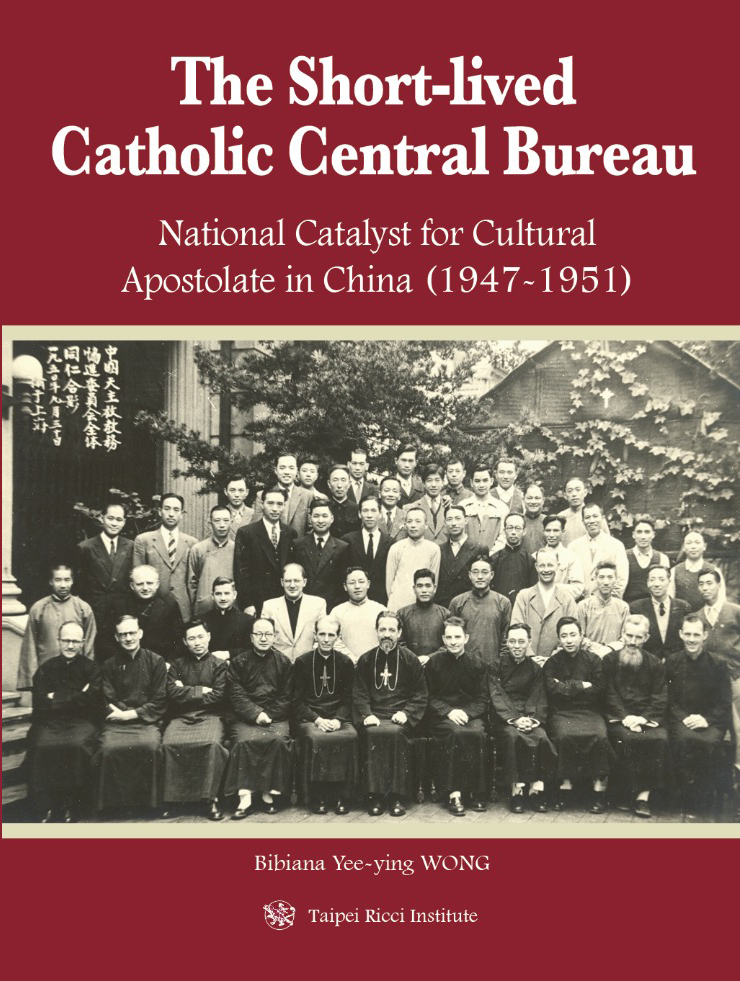利氏學社出版品 《曇花一現:天主教教務協進委員會與中國文化傳教事業(1947-1951)》
The Short-lived Catholic Central Bureau:
National Catalyst for Cultural Apostolate in China (1947-1951)
曇花一現:天主教教務協進委員會與中國文化傳教事業(1947-1951)
作者:Bibiana Yee-ying WONG 黃懿縈
Hardcover: 335 pages Language: English ISBN: 978-957-29848-7-1

本書是研究在戰後中國成立的上海天主教教務協進委員會的首部專著。時值教廷在中國建立教會聖統制,並與國民黨政府展開正式外交關係,教務協進會在教廷駐華公使指導下,集合不同傳教修會的中外籍神職菁英,除了協調近140個教區的傳教活動,特別著重於文化傳教事業,運用現代媒體向城市知識分子傳播基督信仰的價值觀,抗衡唯物論者的反宗教宣傳。它又向全國推廣聖母軍,培育平信徒協助文化傳教,為使一旦神職人員無法履行牧職,天主教團體依然保持活力。最終,教務協進會在中共建國初年被取締,各項計劃未能實現,主要成員遭逮捕、驅逐或在拘禁期間殞命。儘管上海教務協進會鮮明的歷史角色結束,它卻在台北和新加坡開枝散葉,協調全球華人傳教工作,本書的敘述延伸至這兩個鮮少有人研究的機構。
This book may be called a groundbreaking work of research into the historical event of the Shanghai Catholic Central Bureau (CCB), which was an ecclesiastical executive organ set up by the Apostolic Internuncio after the establishment of Sino-Vatican diplomatic relations and the Catholic Hierarchy in post-war China. Besides coordinating missionary activities of nearly 140 dioceses administered by various religious congregations, it promoted a cultural apostolate with the use of modern communication media to guide people in the understanding of the Catholic faith and advise missionary work in the face of anti-religious propaganda by materialists. It also trained the laity through the Legion of Mary to sustain Catholic communities when the clergy was barred from its ministries. Eventually, the CCB could not establish its endeavor due to the Communist ban. Key members of the Bureau were arrested, expelled or died early in prison. Despite its vivid historical role of the CCB in Shanghai, this book also investigates its two “heirs” in Taipei and Singapore to organize the apostolate to the Chinese in diaspora.
關鍵詞:中國天主教、共產主義與基督宗教、聖母軍、政教關係、三自運動
Keywords: Chinese Catholicism, communism and Christianity, Legion of Mary, state-church relations, Three-Self Movement
陳方中教授推薦序,請按此閱讀
Preface by Prof. Chen Fang-chung, click here to read
About the Author
Bibiana Yee-Ying Wong is a postdoctoral fellow at the Institute of Modern History, Academia Sinica in Taiwan. She received her Ph.D. in Religious Studies from Fu Jen Catholic University in 2020. Her research interest is in the history of Chinese Catholicism in the twentieth century. While working as a journalist for two Catholic news organizations in Hong Kong from 2002 to 2013, she obtained Master’s degrees in Journalism and in Religious Studies from the Chinese University of Hong Kong.
黃懿縈是土生土長的香港人,台灣天主教輔仁大學宗教學博士(2020),中央研究院近代史研究所博士後研究學者(2021-2022),研究方向為二十世紀中國天主教歷史與政教關係。曾任職於香港兩間天主教新聞機構(2002-2013),並修畢香港中文大學的新聞學及宗教研究碩士學位。
Table of Contents
Introduction
1 A Zigzag Path to Uniformity
– Historical overview of missionary cooperation before the CCB –
Regional synods in China during late Qing period
New missionary strategy and directives
Celso Costantini and Primum Concilium Sinense
Synodal Commission on Schools, Books and Press
Catholic Action movement and Mario Zanin
2 “The Dizziest Place” in Shanghai
– Creation and organization of the Catholic Central Bureau–
Establishment of the Chinese Catholic Hierarchy
Reorganization of Synodal Commissions by Antonio Riberi
The Catholic Central Bureau in its initial stage
Christianization of China through cultural apostolate
3 Creative Propagators of the Faith
– Five foreign missionaries in the CCB and their work–
François X. Legrand and publication work
Jan Joos and Catholic radio activities
Jozef Vos, Correspondence Courses and his books
Patrick O’Connor and Hua Ming News Service
Aedan W. McGrath and the Legion of Mary
4 Talented Defenders of the Church
– Five Chinese priests in the CCB and their life’s witness –
Matthew Chen, courageous scholar and writer
Joseph Shen, organizer and martyr of the Legion
John Dong and his apologetic speech
John B. Gao and the national congress on Catholic education
John Mao and his fight for the Overseas Student Service
5 Three-Self Reforms and the CCB
– The origin and course of state-church friction –
Opposition between Catholic and Communist ideologies
Religious policy of Chinese Communists
The Three-Self Reform Movement
The CCB’s three responding documents
6 A Tool of the Imperialist Riberi”
– Ban on the CCB and the Legion of Mary –
The first arrest: François Théry
Suspension of the CCB and press attack
Mass arrest of the CCB directors
Crackdown on the Legion of Mary
Tragic death of Jozef Vos
Imprisonment of McGrath and Legrand
7 Aftermath and Continuation
– The CCB’s final days in Shanghai and reestablishment after 1952 –
The CCB chapel and playground
The fate of Bishop James E. Walsh
Riberi restored the CCB in Taiwan
The Singapore Catholic Central Bureau
Conclusion
Bibliography
Index
